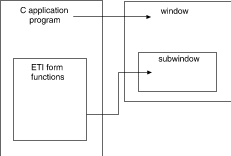 form;
WINDOW
form;
WINDOW  window;
window;
WINDOW  form_win (form)
FORM
form_win (form)
FORM  form;
form;
int set_form_sub (form, window)
FORM  form;
WINDOW
form;
WINDOW  window;
window;
WINDOW  form_sub (form)
FORM
form_sub (form)
FORM  form;
form;
|
|
Remember that
two windows are associated with every form -- the
form window and the form subwindow.
The following functions assign windows and subwindows to forms and
fetch those previously assigned to them.
SYNOPSIS
int set_form_win (form, window) FORMThese functions enable you to place stylistic borders, titles, and other decoration around a form.form; WINDOW
window;
WINDOW
form_win (form) FORM
form;
int set_form_sub (form, window) FORM
form; WINDOW
window;
WINDOW
form_sub (form) FORM
form;
If you do not want to use stdscr, you should create a window and a subwindow for every form. ETI automatically writes all low-level ETI (curses) output of the form proper on the form subwindow. If you want further output (such as borders, titles, or static messages), you should write it on the form window. However, you need not write any further output at all.
``Form functions write to subwindow, application to window'' diagrams the relationship between ETI Form functions, your application program, and its form window and subwindow.

Form functions write to subwindow, application to window
``Creating a border around a form'' shows how to create a form with a border of the terminal's default vertical and horizontal characters.
/* create window 4 characters larger than form dimensions with top left corner at (0, 0). subwindow is positioned at (2, 2) relative to the form window origin with dimensions equal to the form dimensions. */FORM * f; WINDOW * w; int rows, cols;
scale_form (f, &rows, &cols); /* get dimensions of form */
if (w = newwin (rows+4, cols+4, 0, 0)) { set_form_win (f, w); /* associate window and subwindow with form */
set_form_sub (f, derwin (w, rows, cols, 2, 2));
box (w, 0, 0); /* create border */ }
Creating a border around a form
Function scale_form sets the values of the variables rows and cols, which provide the form dimensions without the border. Adding four to the dimensions of the form window clearly sets off the form border from the fields of the form (the form proper).
If functions set_form_win or set_form_sub encounter an error, they return one of the following:
int rows, cols, firstrow, firstcol;/* create form window */
WINDOW * w = newwin (rows, cols, firstrow, firstcol);
set_form_win((FORM *)0, w); /* change default form window to w */
Note that if you later change a posted form by writing directly to its window, before continuing you must reposition the form window cursor using pos_form_cursor. See ``Positioning the form cursor''.